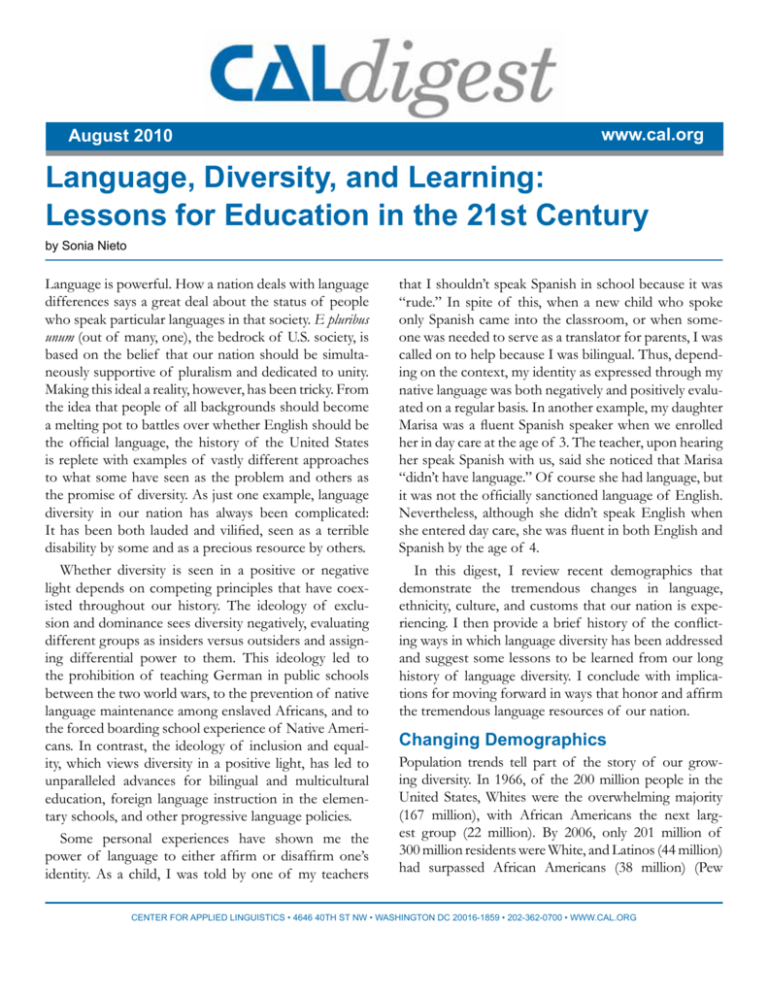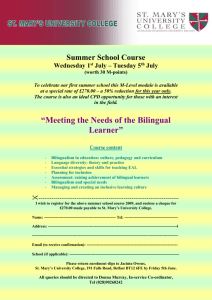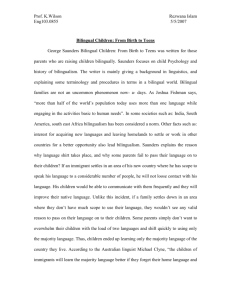Language, Diversity, and Learning: Lessons for Education in the
advertisement

August 2010 www.cal.org Language, Diversity, and Learning: Lessons for Education in the 21st Century by Sonia Nieto Language is powerful. How a nation deals with language differences says a great deal about the status of people who speak particular languages in that society. E pluribus unum (out of many, one), the bedrock of U.S. society, is based on the belief that our nation should be simultaneously supportive of pluralism and dedicated to unity. Making this ideal a reality, however, has been tricky. From the idea that people of all backgrounds should become a melting pot to battles over whether English should be the official language, the history of the United States is replete with examples of vastly different approaches to what some have seen as the problem and others as the promise of diversity. As just one example, language diversity in our nation has always been complicated: It has been both lauded and vilified, seen as a terrible disability by some and as a precious resource by others. Whether diversity is seen in a positive or negative light depends on competing principles that have coexisted throughout our history. The ideology of exclusion and dominance sees diversity negatively, evaluating different groups as insiders versus outsiders and assigning differential power to them. This ideology led to the prohibition of teaching German in public schools between the two world wars, to the prevention of native language maintenance among enslaved Africans, and to the forced boarding school experience of Native Americans. In contrast, the ideology of inclusion and equality, which views diversity in a positive light, has led to unparalleled advances for bilingual and multicultural education, foreign language instruction in the elementary schools, and other progressive language policies. Some personal experiences have shown me the power of language to either affirm or disaffirm one’s identity. As a child, I was told by one of my teachers that I shouldn’t speak Spanish in school because it was “rude.” In spite of this, when a new child who spoke only Spanish came into the classroom, or when someone was needed to serve as a translator for parents, I was called on to help because I was bilingual. Thus, depending on the context, my identity as expressed through my native language was both negatively and positively evaluated on a regular basis. In another example, my daughter Marisa was a fluent Spanish speaker when we enrolled her in day care at the age of 3. The teacher, upon hearing her speak Spanish with us, said she noticed that Marisa “didn’t have language.” Of course she had language, but it was not the officially sanctioned language of English. Nevertheless, although she didn’t speak English when she entered day care, she was fluent in both English and Spanish by the age of 4. In this digest, I review recent demographics that demonstrate the tremendous changes in language, ethnicity, culture, and customs that our nation is experiencing. I then provide a brief history of the conflicting ways in which language diversity has been addressed and suggest some lessons to be learned from our long history of language diversity. I conclude with implications for moving forward in ways that honor and affirm the tremendous language resources of our nation. Changing Demographics Population trends tell part of the story of our growing diversity. In 1966, of the 200 million people in the United States, Whites were the overwhelming majority (167 million), with African Americans the next largest group (22 million). By 2006, only 201 million of 300 million residents were White, and Latinos (44 million) had surpassed African Americans (38 million) (Pew Center for Applied Linguistics • 4646 40TH ST NW • WASHINGTON DC 20016-1859 • 202-362-0700 • www.cal.org Hispanic Center, 2006). Given current immigration trends, the U.S. Census Bureau (2000) projects that before 2050, Whites will constitute less than half of the population, while Latinos will comprise nearly one quarter of all U.S. residents. Demographic changes are even more evident in our nation’s schools. In 1970, at the height of the public school enrollment of the baby boom generation, White students made up 79% of total enrollment, followed by 14% African American, 6% Hispanic, and 1% Asian and Pacific Islander and other races. Currently, approximately 60% of students in U.S. public schools are White, while 18% are Hispanic, 16% are African American, and 4% are Asian or other races (U.S. Census Bureau, 2009). In addition, more than 49 million students, or 31% of those enrolled in U.S. elementary and secondary schools, are foreign born or have at least one parent who is foreign born (Shin, 2005). As a result, schools, like the broader society, look very different than they did 40 years ago, and these differences have tremendous implications for how we define and carry out education. A Complicated History Various approaches have been used over the years to address language diversity in U.S. schools, from “sink or swim” practices—in which education for all students occurs in English, with no provision for nonnative speakers—to bilingual education, which makes use of students’ native languages in addition to English. Speaking a language or dialect other than Standard English has often been viewed as a burden, something to be abandoned as soon as possible. This is nowhere more evident than in our nation’s public schools. The history of bilingual education is testament to this belief, as seen in the changing attitudes toward the use of languages other than English in education. Although the latest iteration of bilingual education started in the 1960s, educating children through the use of their native language while they are also learning English has a much longer history in the United States. For instance, bilingual instruction in German and English was quite common in the Midwest in the 1800s, and by 1900, at least 600,000 children, or approximately 4% of U.S. students enrolled in public and parochial elementary schools, were being taught in German/English bilingual schools, with smaller numbers in bilingual schools for speakers of Polish, Italian, Norwegian, Spanish, French, Czech, Dutch, and other languages (Crawford, 1992). The decline of 2 the use of native languages in public schooling began around the time of World War I—due primarily to a backlash against using the German language in schools and in public—and continued through World War II, when Germany was once again our major enemy. It was not until the era of the civil rights movement that language issues again became prominent in schools and society. The struggle for bilingual education that began anew in the 1960s was based on the premise that teaching children in their native language could help turn around the abysmal educational outcomes that were (and still are) all too common for many immigrants, particularly Latinos. From the 1960s to the 1990s, many advocates took to the streets, legislatures, and courts to advocate for bilingual education. The results can be seen in such legislation as the Bilingual Education Act of 1968 and in such court cases as Lau v. Nichols (1974). In Lau v. Nichols, the U.S. Supreme Court recognized the connection between native language differences and equal educational opportunity by ruling unanimously that the civil rights of students who did not understand the language of instruction were indeed being violated. The court did not mandate native language instruction as the remedy, just some treatment that would reduce the disadvantage. Nevertheless, this ruling gave the green light to a variety of approaches, and bilingual education soon became the preferred method for teaching language minority students. Many studies have shown bilingual education to be more effective than programs that do not use the students’ native language, but in spite of this research, the public has always been deeply divided over this approach (August & Shanahan, 2006; Crawford, 2008; Cummins, 2001; Rolstad, Mahoney, & Glass, 2005; Thomas & Collier, 2002). Although the benefits of proficiency in languages other than English have at times been recognized, the benefits are more often seen for native English speakers who learn other languages. Generally, the languages spoken by immigrants to the United States or by indigenous populations are not acknowledged as beneficial, and using those languages for academic instruction is not accepted as desirable or beneficial. In fact, there have been recent instances of outright hostility toward native language instruction, no doubt due in large part to growing immigration, particularly from Mexico. Examples of this hostility can be seen in a series of state refer- enda approved by the voters, beginning with California’s English Language in Public Schools Statute of 1998, popularly known as Proposition 227, which resulted in the elimination of bilingual education in the state. This was followed by similar propositions in Arizona (Proposition 203, English for Children, 2000) and Massachusetts (Question 2, 2002). Lessons to Be Learned Given the complicated history of language diversity in our nation, what are the lessons to be learned? Although there are many, let me focus briefly on just three: • Diversity is a resource, not a problem. • Students learning English need more than language instruction. • The families of second language learners need to be welcomed in school and involved in the education of their children. Diversity Is a Resource, Not a Problem This is true for everyone, not just for those who speak a language other than English. Our nation’s long history with language diversity has shown us that knowing more than one language is an asset rather than a disability, particularly in these times of globalization and increased immigration. The cognitive benefits of bilingualism for both young people and adults have been clearly demonstrated (Gándara, 1995; Howard, Christian, & Genesee, 2004). For the elderly, bilingualism seems to postpone dementia: A team of Canadian researchers who studied people being treated for dementia found that those who regularly used two languages reported their first symptoms of a fading memory about 4 years later than those who used only one language (Bialystok, Craik, & Freedman, 2007). Bilingualism has other benefits as well. For example, in their review of research studies concerning the adaptation and school achievement of immigrants of various backgrounds, Portes and Rumbaut (2001) found that immigrant students with limited bilingualism (including students who spoke their native language but had not yet mastered English and students who spoke English but had lost their native language) were far more likely to drop out of school than those who were fluent in both English and their native language. As a result, these researchers conclude that, rather than impeding academic achievement, bilingualism can actually promote learning. Yet our commitment to helping immigrant students develop and maintain their native language skills is weak, as is our commitment to foreign language education for native English speakers. In public K–12 education, this commitment is becoming even weaker (Rhodes & Pufahl, 2010). Millions of native as well as second language speakers every year lose the potential to maintain and develop their language skills because of our national reluctance to support native and foreign language instruction, resulting in woefully inadequate national language abilities (García, 2008). This situation has implications for everything from national security to our role as a global leader. Students Learning English Need More Than Language Instruction Why do we persist in thinking that students learning English can only be learning English? This is what Luis Moll (1992, p. 20) has termed “the obsession with speaking English,” as if learning English were the solution to all the difficulties faced by students who are not native speakers of English. All students should learn English, of course, and they should learn it well, but they also need to learn science, math, music, art, social studies, and other content. If learning English is their sole challenge, how do we account for the 50% high school dropout rate among Latinos, African Americans, and Native Americans, even among those who are fluent in English (Orfield, 2004), including some who are monolingual English speakers? At the same time that we teach all students English, we need to focus on the crushing conditions that pose tremendous barriers to student learning: poverty, racism, inequality, poorly financed schools, tracking, unfair testing policies, lack of access to an excellent education, and negative ideologies about bilingual education and second language learners (Kozol, 2005). The Families of Second Language Learners Need to Be Welcomed and Involved in the Education of Their Children Family involvement is key to student learning and engagement with school. Yet teachers and administrators often assume that some families of immigrant students and students for whom English is a second language are not interested in their children’s education because they do not attend traditional parent activities (Valdés, 1996). As a result, these families are often marginalized in spite 3 of the fact that they could be a tremendous resource to the school. Providing professional development for teachers and administrators on effective ways to connect with parents is one successful approach to having families more involved in the education of their children. The theory of funds of knowledge, in which teachers engage in ethnographic research with the families of their students in order to discover the talents and strengths of those families and use them in crafting the curriculum (González, Moll, & Amanti, 2005), is a case in point. This approach assumes that all families can make significant contributions to the education of their children. Conclusion These three lessons, as well as the checkered history of attitudes toward language diversity in our nation, confirm the statement at the beginning of this digest that language is powerful, regardless of the particular language or language variety involved. Paulo Freire, the late Brazilian educator, articulated this idea powerfully when discussing the notion of standard language: When did a certain form of grammar become “correct”? Who named the language of the elite as “correct,” as the standard? They did, of course. But why not call it “Upper-class Dominating English” instead of “Standard English”? That authentic naming would reveal, instead of obscure, the politics of power and language in society. (Shor & Freire, 1987, p. 45) One thing is clear: Teachers, administrators, and advocates for equal and quality education for all students, including students who speak languages other than English, need to use the knowledge, research, experience, and power available to them to work to improve understanding of language and culture to ensure that language diversity is dealt with in ways that benefit our nation and all of the students we seek to educate. References August, D., & Shanahan, T. (Eds.). (2006). Developing literacy in secondlanguage learners. Mahwah, NJ: Erlbaum. Bialystok, E., Craik, F. I. M., & Freedman, M. (2007). Bilingualism as a protection against the onset of symptoms of dementia. Neuropsychologia, 45, 459-464. 4 Crawford, J. (1992). Hold your tongue: Bilingualism and the politics of “English only.” Reading, MA: Addison-Wesley. Crawford, J. (2008). Advocating for English learners: Selected essays. Bristol, United Kingdom: Multilingual Matters. Cummins, J. (2001). Language, power, and pedagogy: Bilingual children in the crossfire. Clevedon, UK: Multilingual Matters. Gándara, P. (1995). Over the ivy walls: The educational mobility of low-income Chicanos. Albany: State University of New York Press. García, O. (2008). Bilingual education in the 21st century: A global perspective. Indianapolis, IN: Wiley-Blackwell. González, N. E., Moll, L. C., & Amanti, C. (Eds.). (2005). Funds of knowledge: Theorizing practices in households and classrooms. Mahwah, NJ: Erlbaum. Howard, E. R., Christian, D., & Genesee, F. (2004). The development of bilingualism and biliteracy from grade 3 to 5: A summary of findings from the CAL/CREDE study of two-way immersion education (Research Rep. No 13). Santa Cruz, CA: Center for Research on Education, Diversity & Excellence. Kozol, J. (2005). The shame of the nation: The restoration of Apartheid schooling in America. New York: Crown. Lau v. Nichols, 414 U.S. 563 (1974). Moll, L. C. (1992). Bilingual classroom studies and community analysis: Some recent trends. Educational Researcher, 21(2), 20-24. Orfield, G. (2004). Dropouts in America: Confronting the graduate rate crisis. Cambridge, MA: Harvard Education Press. Pew Hispanic Center. (2006, October 10). From 200 million to 300 mil­­ lion: The numbers behind population growth (Fact Sheet). Washington, DC: Author. Retrieved January 6, 2010, from http://pewhispanic­­ .org/files/factsheets/25.pdf Portes, A., & Rumbaut, R. G. (2001). Legacies: The story of the immigrant second generation. Berkeley: University of California Press. Rhodes, N. C., & Pufahl, I. (2010). Foreign language teaching in U.S. schools: Results of a national survey. Washington, DC: Center for Applied Linguistics. Rolstad, K., Mahoney, K., & Glass, G. V. (2005). The big picture: A meta-analysis of program effectiveness research on English language learners. Educational Policy, 19(4), 572-594. Shin, H. B. (2005). School enrollment—Social and economic characteristics of students: October 2003 (Current Population Reports). Washington, DC: U.S. Census Bureau. Retrieved January 6, 2010, from http:// www.census.gov/prod/2005pubs/p20-554.pdf Shor, I., & Freire, P. (1987). A pedagogy for liberation: Dialogues on transforming education. Granby, MA: Begin & Garvey Publishers. Thomas, W. P., & Collier, V. (2002). National study of school effectiveness for language minority students’ long-term academic achievement. Santa Cruz, CA: Center for Research on Education, Diversity & Excellence. U.S. Census Bureau. (2000). Population projections: U.S. interim projections by age, sex, race, and Hispanic origin: 2000-2050. Retrieved January 6, 2010, from http://www.census.gov/population/www/projections/ usinterimproj/ U.S. Census Bureau. (2009, March 5). Current population survey. Washington, DC: Author. Valdés, G. (1996). Con respeto: Bridging the distance between culturally diverse families and schools. New York: Teachers College Press.







